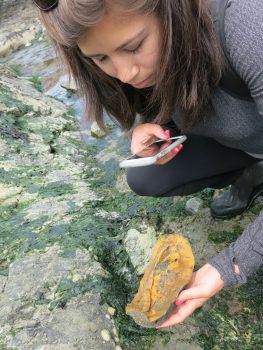Q & A With Erin Murray
 Why did you decide to pursue a Master of Marine Affairs?
Why did you decide to pursue a Master of Marine Affairs?
I received my undergraduate degree in policy and planning from a similar environmental interdisciplinary program, but not focused on the marine environment. I believed that a MMA would help fill my knowledge gaps on key marine issues, while providing me the flexibility to build a thesis built on primary research.
Why did you decide to come to UW’s SMEA for graduate school?
I was born and raised in Seattle and have a deep love for the Salish Sea. Other schools I applied to did not have the accessibility to marine industry, governmental agencies, or even the ocean. From the SMEA lounge you have a view of Seattle houseboats and the NOAA NW Fisheries Science Center. You can watch the Alaskan fishing fleet going out to Puget Sound through the locks. I can take my bike and ride 20 minutes to see sea lions and humpbacks off the coast. Most importantly, I knew SMEA had the alumni connections to launch me into a career working to solve marine policy issues in the Salish Sea.
Are you doing a thesis or capstone project? If thesis, what are you writing your thesis about and why? If capstone, what is the project about?
I am currently working on a thesis project exploring the capacity for eelgrass habitat to store carbon in the sediment with the help from the Padilla Bay National Estuarine Research Reserve and the Laird Norton Family Foundation. I am specifically looking at two different types of eelgrass habitat environments: an active delta and an inactive delta. By measuring how much carbon is stored in these habitats, we can suggest ways to make up for human carbon emissions by using eelgrass in Washington State. Understanding these ecosystem benefits is especially important when forecasting the change in distribution of eelgrass due to climate change, and how that may change our carbon sink capacity in the future.
What has been your favorite class at UW so far? Why?
SMEA 506: International Law of the Sea. This class was cross-listed with the UW Law School taught by Professor Craig Allen. In a class where half the students were JDs, it was intimidating! However, meeting fellow students in other departments at UW has been the most rewarding aspect of SMEA.
What do you like most about SMEA?
The accessibility of professors and staff. I always feel that I can pop in for a quick question or just to say Hi. Without this accessibility and support, I don’t think I could have developed a thesis focused on primary research.
What’s it like to live in Seattle? What do you do in your spare time?
As a Seattleite, I am biased. Seattle is going through exciting change as the city grows to accommodate young people moving here for the explosion of jobs in the tech industry. In my spare time I rotate sports between the seasons – everything from snowshoeing, biking around the islands, backpacking in the mountains, or kayaking down the rivers. Most activities are only a 45-minute drive from the city.
If you could design your ultimate job after graduating, what would it be and why?
I would love the opportunity to solve new and emerging coastal development issues by partnering with industry. As coastal cities like Seattle continue to grow, I believe developing sustainably is key to preserving the beauty, health and biodiversity of our urban coastlines.
What is your favorite form of marine life, and why?
Eelgrass! There is something so surreal being in an eelgrass bed at low tide – it looks like an underwater meadow. I have seen so much marine life in eelgrass beds while collecting samples: from curious seals, Dungeness crab, and even a spiny dogfish.